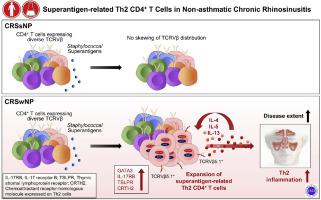当前位置:
X-MOL 学术
›
J. Allergy Clin. Immunol.
›
论文详情
Our official English website, www.x-mol.net, welcomes your feedback! (Note: you will need to create a separate account there.)
Superantigen-related TH2 CD4+ T cells in nonasthmatic chronic rhinosinusitis with nasal polyps.
Journal of Allergy and Clinical Immunology ( IF 14.2 ) Pub Date : 2020-01-25 , DOI: 10.1016/j.jaci.2019.12.915 Min-Seok Rha 1 , Sang-Wook Kim 2 , Dong-Yeop Chang 3 , Jin-Ku Lee 4 , Jihye Kim 5 , Su-Hyung Park 6 , Roza Khalmuratova 7 , Hee-Suk Lim 8 , Kyoung Mi Eun 8 , Seung-No Hong 8 , Dae Woo Kim 8 , Eui-Cheol Shin 6
Journal of Allergy and Clinical Immunology ( IF 14.2 ) Pub Date : 2020-01-25 , DOI: 10.1016/j.jaci.2019.12.915 Min-Seok Rha 1 , Sang-Wook Kim 2 , Dong-Yeop Chang 3 , Jin-Ku Lee 4 , Jihye Kim 5 , Su-Hyung Park 6 , Roza Khalmuratova 7 , Hee-Suk Lim 8 , Kyoung Mi Eun 8 , Seung-No Hong 8 , Dae Woo Kim 8 , Eui-Cheol Shin 6
Affiliation

|
BACKGROUND
Staphylococcus aureus enterotoxin (SAE) superantigens are detected in nasal polyps (NPs), and SAE-specific IgE predicts asthma comorbidity in patients with NPs. However, roles of SAE superantigens and superantigen-related T-cell responses remain to be elucidated in nonasthmatic patients.
OBJECTIVE
We investigated the presence of SAEs and SAE-related T-cell receptor (TCR) Vβ (TCRVβ) in nonasthmatic NPs, the phenotypes and functions of SAE-related T cells, and the clinical implication of SAE-related T-cell expansion.
METHODS
Sinonasal tissue samples were obtained from patients with nonasthmatic chronic rhinosinusitis (CRS) with NPs (CRSwNP), patients with CRS without NPs (CRSsNP), and control subjects. SAE genes were detected by PCR, and the TCRVβ distribution and T-cell phenotypes were examined by flow cytometry.
RESULTS
Various SAE genes were detected not only in NPs but also in sinonasal mucosa from patients with CRSsNP and from controls. The S aureus enterotoxin I (SEI) gene was detected in all NPs. The fraction of SEI-responsive TCRVβ+ (TCRVβ1+ and Vβ5.1+) CD4+ T cells was significantly increased only in NPs and the ethmoidal mucosa of patients with CRSwNP, indicating superantigen-induced expansion. The expanded TCRVβ5.1+ CD4+ T cells expressed proliferation marker Ki-67 and the TH2 transcription factor GATA3. Furthermore, TCRVβ5.1+ CD4+ T cells in NPs highly expressed TH2 markers, including IL-17RB, thymic stromal lymphoprotein receptor, and chemoattractant receptor-homologous molecule expressed on TH2 cells, with a potent TH2 cytokine-producing ability. Moreover, the expansion of TCRVβ1+ or Vβ5.1+ CD4+ T cells was associated with the Lund-Mackay computed tomography score, indicating disease extent.
CONCLUSION
In nonasthmatic patients with CRSwNP, superantigen-related expansion of CD4+ T cells with TH2 differentiation was associated with the disease extent.
中文翻译:

非哮喘性慢性鼻-鼻窦炎伴鼻息肉的超抗原相关的TH2 CD4 + T细胞。
背景技术在鼻息肉(NPs)中检测到金黄色葡萄球菌肠毒素(SAE)超抗原,并且SAE特异性IgE可以预测NPs患者的哮喘合并症。然而,对于非哮喘患者,SAE超级抗原和与超级抗原相关的T细胞反应的作用仍有待阐明。目的我们研究非哮喘性NP中SAE和SAE相关的T细胞受体(TCR)Vβ(TCRVβ)的存在,SAE相关的T细胞的表型和功能,以及SAE相关的T细胞扩增的临床意义。方法鼻窦组织样本取自患有非哮喘性慢性鼻鼻窦炎(CRS)和NP的患者(CRSwNP),不伴NPs的CRS的患者(CRSsNP)和对照组。通过PCR检测SAE基因,并通过流式细胞术检查TCRVβ分布和T细胞表型。结果不仅在NPs中,而且在CRSsNP患者和对照组的鼻窦粘膜中均检测到各种SAE基因。在所有NP中均检测到金黄色葡萄球菌肠毒素I(SEI)基因。仅在CRSwNP患者的NP和筛窦粘膜中,SEI响应性TCRVβ+(TCRVβ1+和Vβ5.1+)CD4 + T细胞的比例显着增加,表明超抗原诱导的扩增。扩增的TCRVβ5.1+ CD4 + T细胞表达了增殖标志物Ki-67和TH2转录因子GATA3。此外,NPs中的TCRVβ5.1+ CD4 + T细胞高表达TH2标志物,包括IL-17RB,胸腺基质淋巴蛋白受体和在TH2细胞上表达的趋化性受体同源分子,具有强大的TH2细胞因子产生能力。而且,TCRVβ1+或Vβ5的扩增。1+ CD4 + T细胞与Lund-Mackay计算机断层扫描评分相关,表明疾病程度。结论在非哮喘性CRSwNP患者中,与TH2分化有关的CD4 + T细胞超抗原相关性扩张与疾病程度有关。
更新日期:2020-01-25
中文翻译:

非哮喘性慢性鼻-鼻窦炎伴鼻息肉的超抗原相关的TH2 CD4 + T细胞。
背景技术在鼻息肉(NPs)中检测到金黄色葡萄球菌肠毒素(SAE)超抗原,并且SAE特异性IgE可以预测NPs患者的哮喘合并症。然而,对于非哮喘患者,SAE超级抗原和与超级抗原相关的T细胞反应的作用仍有待阐明。目的我们研究非哮喘性NP中SAE和SAE相关的T细胞受体(TCR)Vβ(TCRVβ)的存在,SAE相关的T细胞的表型和功能,以及SAE相关的T细胞扩增的临床意义。方法鼻窦组织样本取自患有非哮喘性慢性鼻鼻窦炎(CRS)和NP的患者(CRSwNP),不伴NPs的CRS的患者(CRSsNP)和对照组。通过PCR检测SAE基因,并通过流式细胞术检查TCRVβ分布和T细胞表型。结果不仅在NPs中,而且在CRSsNP患者和对照组的鼻窦粘膜中均检测到各种SAE基因。在所有NP中均检测到金黄色葡萄球菌肠毒素I(SEI)基因。仅在CRSwNP患者的NP和筛窦粘膜中,SEI响应性TCRVβ+(TCRVβ1+和Vβ5.1+)CD4 + T细胞的比例显着增加,表明超抗原诱导的扩增。扩增的TCRVβ5.1+ CD4 + T细胞表达了增殖标志物Ki-67和TH2转录因子GATA3。此外,NPs中的TCRVβ5.1+ CD4 + T细胞高表达TH2标志物,包括IL-17RB,胸腺基质淋巴蛋白受体和在TH2细胞上表达的趋化性受体同源分子,具有强大的TH2细胞因子产生能力。而且,TCRVβ1+或Vβ5的扩增。1+ CD4 + T细胞与Lund-Mackay计算机断层扫描评分相关,表明疾病程度。结论在非哮喘性CRSwNP患者中,与TH2分化有关的CD4 + T细胞超抗原相关性扩张与疾病程度有关。



























 京公网安备 11010802027423号
京公网安备 11010802027423号